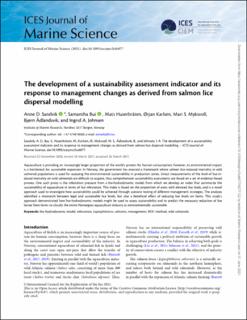| dc.contributor.author | Sandvik, Anne Dagrun | |
| dc.contributor.author | Bui, Samantha | |
| dc.contributor.author | Huserbråten, Mats Brockstedt Olsen | |
| dc.contributor.author | Karlsen, Ørjan | |
| dc.contributor.author | Myksvoll, Mari Skuggedal | |
| dc.contributor.author | Ådlandsvik, Bjørn | |
| dc.contributor.author | Johnsen, Ingrid Askeland | |
| dc.date.accessioned | 2021-06-03T09:33:06Z | |
| dc.date.available | 2021-06-03T09:33:06Z | |
| dc.date.created | 2021-05-25T09:25:11Z | |
| dc.date.issued | 2021 | |
| dc.identifier.issn | 1054-3139 | |
| dc.identifier.uri | https://hdl.handle.net/11250/2757523 | |
| dc.description.abstract | Aquaculture is providing an increasingly larger proportion of the world’s protein for human consumption; however, its environmental impact is a bottleneck for sustainable expansion. In Norway, the government has enacted a framework where salmon lice-induced mortality in wild salmonid populations is used for assessing the environmental sustainability in production zones. Direct measurements of the level of lice-induced mortality on wild salmonids are difficult to acquire, thus comprehensive sustainability assessments are based on a set of evidence-based proxies. One such proxy is the infestation pressure from a bio-hydrodynamic model, from which we develop an index that summarize the sustainability of aquaculture in terms of lice infestation. This index is based on the proportion of areas with elevated lice loads, and is a novel approach used to investigate how sustainability could be achieved through scenario testing of different management strategies. The analyses identified a mismatch between legal and sustainable lice levels, but also a beneficial effect of reducing lice levels on farms. This study’s approach demonstrated how bio-hydrodynamic models might be used to assess sustainability and to predict the necessary reduction of lice larvae from farms to classify the entire Norwegian aquaculture industry as environmentally sustainable. | en_US |
| dc.language.iso | eng | en_US |
| dc.title | The development of a sustainability assessment indicator and its response to management changes as derived from salmon lice dispersal modelling | en_US |
| dc.type | Peer reviewed | en_US |
| dc.type | Journal article | en_US |
| dc.description.version | publishedVersion | en_US |
| dc.source.journal | ICES Journal of Marine Science | en_US |
| dc.identifier.doi | 10.1093/icesjms/fsab077 | |
| dc.identifier.cristin | 1911582 | |
| dc.relation.project | Havforskningsinstituttet: 14650 | en_US |
| cristin.ispublished | true | |
| cristin.fulltext | original | |
| cristin.qualitycode | 1 | |
